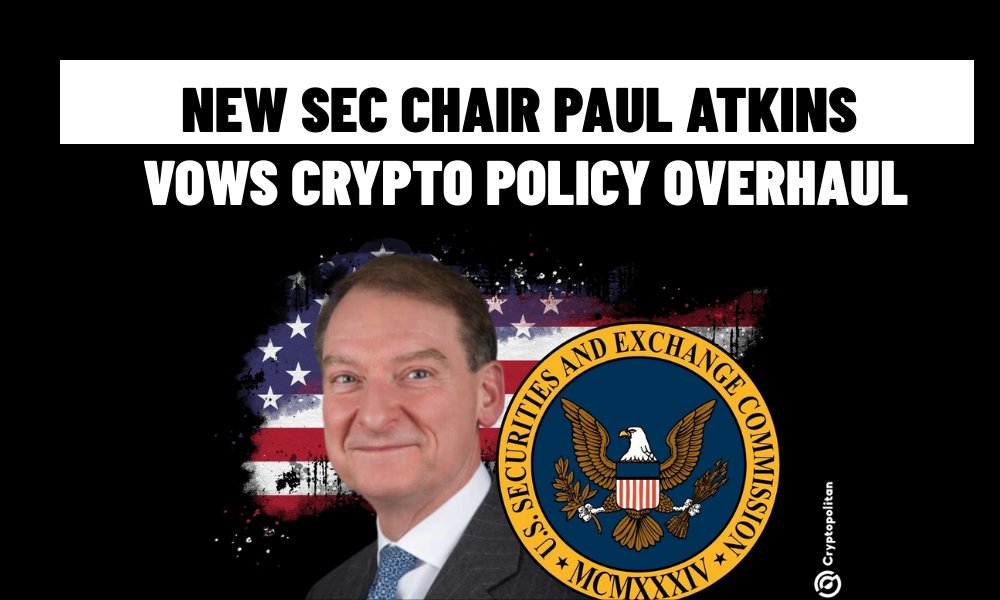Paul Atkins, the newly appointed Chairman of the U.S. Securities and Exchange Commission (SEC), has pledged a comprehensive reform of cryptocurrency regulations in his first public address since taking office. Speaking at a crypto-focused SEC symposium in Washington, D.C., on April 26, 2025, Atkins criticized the “legal uncertainty” created under former Chairman Gary Gensler, accusing his predecessor’s policies of stifling innovation and destabilizing the crypto market. His remarks signal a seismic shift in the SEC’s approach, aligning with the pro-crypto stance of the Trump administration.
Atkins’ Vision for Crypto Regulation
Atkins, a former SEC Commissioner under President George W. Bush, emphasized the need for clear, transparent, and market-friendly regulations. He argued that the SEC’s prior “regulation by enforcement” strategy—marked by aggressive lawsuits against major crypto firms like Coinbase, Binance, and Ripple—hindered progress. “The lack of regulatory clarity has driven innovation overseas and left investors vulnerable,” Atkins stated, vowing to prioritize a framework that fosters innovation while protecting market integrity.

Key elements of Atkins’ proposed reforms include:
Defining Crypto Assets: Clarifying the distinction between securities and commodities to resolve disputes over whether tokens like XRP or Ethereum are unregistered securities. This could lead to re-evaluating high-profile cases, such as SEC vs. Ripple.
Streamlined Compliance: Reducing regulatory burdens for crypto projects to encourage U.S.-based development and investment.
Stablecoin Framework: Supporting the development of a national stablecoin with clear legal backing, potentially reshaping digital dollar transactions.
End to Hostile Enforcement: Halting what Atkins called “politically motivated” actions against crypto firms, a direct jab at Gensler’s tenure.
Atkins’ appointment, endorsed by President Trump as “the perfect man” for the role, reflects a broader push to make the U.S. the “crypto capital of the world.” Posts on X echo this sentiment, with users like @Crypto_TownHall celebrating the end of the SEC’s “war on crypto.”
Critique of Gensler’s Legacy
Atkins didn’t hold back in his critique of Gary Gensler, labeling him the “most destructive” SEC Chairman in history. Under Gensler, the SEC pursued over 100 enforcement actions against crypto entities, including lawsuits against Kraken, Coinbase, and Ripple, often alleging that tokens were unregistered securities. These actions, Atkins argued, created a chilling effect, pushing firms to jurisdictions with clearer regulations, like Singapore and the EU, which adopted the MiCA framework in 2022.
Gensler’s approach, dubbed “regulation by enforcement,” drew widespread criticism from the crypto community. Posts on X from users like @AbsGMCrypto highlight Atkins’ prior advocacy for lighter regulation and his role in the Token Alliance, which promoted blockchain innovation, as evidence of his pro-crypto stance. Gensler resigned in January 2025, shortly before Trump’s inauguration, preempting a potential dismissal.

Market and Industry Implications
Atkins’ reforms could have profound effects on the crypto market, which has seen renewed vigor in 2025. Bitcoin is trading above $94,000, Solana hit an all-time high, and XRP surged to a three-year peak following regulatory clarity. The launch of XRP futures on the Chicago Mercantile Exchange (CME) on May 19, 2025, and proposals for Bitcoin and Solana ETFs underscore growing institutional interest.
Industry leaders have welcomed Atkins’ appointment. Coinbase CEO Brian Armstrong, who met with Trump alongside other crypto executives, praised the shift toward regulatory clarity. Ripple’s Brad Garlinghouse called Atkins’ leadership a “positive signal” for the industry, especially as the SEC’s case against Ripple nears a resolution by May 22, 2025. The $200 million raised for Trump’s inauguration, including $1 million each from Coinbase and Kraken, reflects the industry’s alignment with the new administration.
Technical indicators support the bullish outlook. Bitcoin’s bullish cross and Solana’s break above $200 suggest a market poised for further gains, potentially amplified by Atkins’ policies. XRP’s ascending triangle pattern, with resistance at $2.60, could see a breakout to $3 if regulatory tailwinds persist.
Challenges and Risks
While Atkins’ reforms are promising, challenges remain. Overhauling the SEC’s approach requires coordination with Congress, where crypto legislation has historically stalled. The Republican-controlled Senate and House may expedite bills like the Fit for the 21st Century Act, which could classify decentralized assets as commodities, but political gridlock or competing priorities could delay progress.
Market volatility is another concern. A crypto-wide correction, particularly if Bitcoin falls below $90,000, could temper enthusiasm. Additionally, while Atkins aims to reduce enforcement, ensuring investor protection without stifling innovation will be a delicate balance. The EU’s MiCA framework, which faced criticism for overregulating DeFi and NFTs, serves as a cautionary tale.
Paul Atkins’ leadership at the SEC marks a turning point for U.S. crypto policy. His commitment to clear regulations and his critique of Gensler’s heavy-handed tactics resonate with an industry eager for stability. With Bitcoin nearing $100,000, institutional capital flowing in, and altcoins like XRP and Solana gaining traction, Atkins’ reforms could cement the U.S. as a global crypto hub. However, navigating legislative hurdles and market risks will be critical to realizing this vision. For now, the crypto community is optimistic, with Atkins’ tenure heralding a new era of innovation and opportunity.
